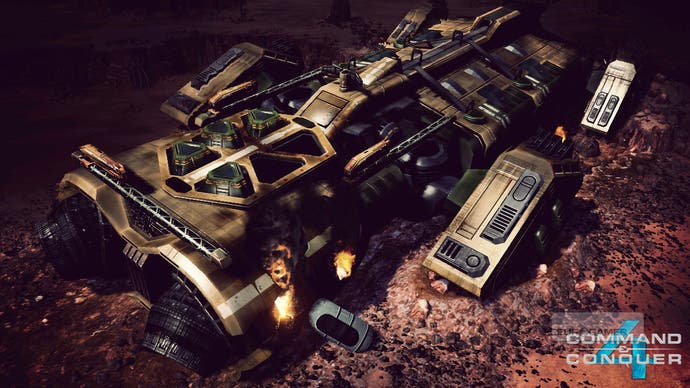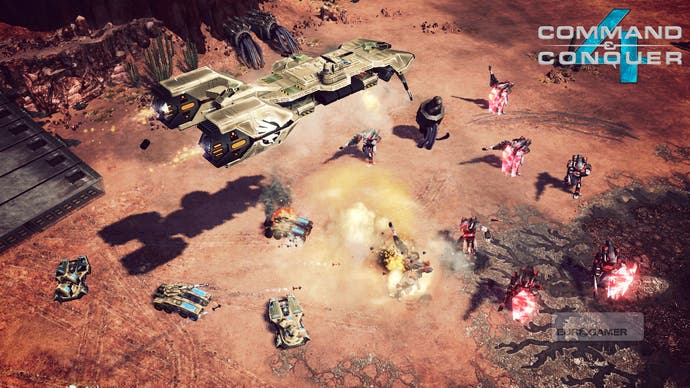Command & Conquer 4
The C&C arc comes to a close. We visit EA LA to find out how and why.
Let's begin at the end, because that's what Command & Conquer 4 is: the conclusion to a sweeping PC favourite, the last entry in a classic - and convoluted - soap opera. Here, in a tiny meeting room at EA LA's headquarters, the team behind Kane's latest battle have spent the last few hours taking us through the entire narrative arc of the series. Now, they're going to give us a few hints on how they're about to finish it all off. "We didn't want to do just another sequel," says Sam Bass, the campaign and story lead for C&C4, a man who's voice seems to have at least four different accents swimming about in it, suggesting that he's possibly arrived from the future himself, and a time when national boundaries no longer have meaning. "We didn't want an enigmatic fade to white. We wanted to bring the story to a close."
And we're almost tempted to believe him, even though conclusions are about as convincing in videogames as they are in cinema and penny dreadfuls, each tumble over Reichenbach Falls strangely susceptible to rewriting when there's enough money on the table. Even within C&C there's plenty of precedents: Kane, after all, has been ionised, blown to pieces, and splattered across Temple Prime so many times by now that he's a bit like Phil Connors in Groundhog Day, except with a pointy beard and a preponderance for odd hand gestures.
But listen for the finer print: "We're not ending the universe, necessarily," adds Bass quickly. "But we wanted to bring this particular arc to a resounding close." EA isn't talking about writing off C&C for good, then - after all, a cash cow of these proportions is harder to fell than a well-structured tank rush. Instead, they're rounding out this episode. Bye-bye Kane. So long Tiberium. Thanks for all the memories (and the weird genetic mutations).

Here's how they're going to do it: C&C4's story starts about 10 years after the end of Kane's Wrath. Humanity is running out of air and water as Tiberium ravages the Earth. That's when Kane reappears, and approaches the GDI with a proposition. He's designed a system that allows him to control Tiberium across the planet, but he needs help to build it. Despite its suspicions, the GDI agrees.
The campaign kicks off 15 years after that, as the Tiberium Control Network nears completion. The partnership has worked, but there's mutual distrust and military escalation on both sides. "We're on the cusp of a new golden age, but there's still this sense of unease," says Bass. "Things went a little too well. So we're asking: what drove Kane to turn his back on Tiberium? And what does he want in return?"

Only two campaigns have been announced so far - EA remains tight-lipped on whether the Scrin will feature again - and their focus reveals a good deal about the directions the game is heading in. C&C4 is, unsurprisingly, aimed at netting as wide an audience as possible, and that means catering for players of varying depths of skill and knowledge of the series. "We wanted a lot for long-term fans, but there's an entry point for people who don't want to go back through the last game too," says Bass. "We want it to be friendly."
"For GDI, we have a campaign called The Man who Killed Kane," he continues. "It's an action-oriented sci-fi story, a little Bourne Identity, a little 24. The idea is to do the big explosive conclusion to the Tiberium saga. People play GDI first, so it's designed to fill in the gaps and explain the lore. Then there's the Nod campaign. It's called All Things Must End, and this is the big one. It reveals the truth behind Kane's plan: who he is, what he wants, and why. It's a darker tale. We want you to see your actions from a new perspective, and wonder, 'Maybe what I was doing in the GDI campaign was not so much saving the world as making it worse.' This campaign is for the hardcore: this is their ending."




.png?width=291&height=164&fit=crop&quality=80&format=jpg&auto=webp)



